Identification of Patterns in CO2 Emissions among 208 Countries: K-Means Clustering Combined with PCA and Non-Linear t-SNE Visualization
Abstract
:1. Introduction
2. Literature Review
3. Data Collection and Exploratory Analysis
4. Methodology
5. Empirical Results and Discussion
5.1. Clustering for Total CO2 Emissions
5.2. Clustering for CO2 per Capita Emissions
6. General Discussion
7. Conclusions
Author Contributions
Funding
Data Availability Statement
Conflicts of Interest
Appendix A
Appendix B
| PCA Cluster | Countries |
|---|---|
| 1 | Afghanistan, Albania, Andorra, Angola, Anguilla, Antigua and Barbuda, Argentina, Armenia, Aruba, Austria, Azerbaijan, Bahamas, Bahrain, Bangladesh, Barbados, Belarus, Belgium, Belize, Benin, Bermuda, Bhutan, Bolivia, Bonaire Sint Eustatius and Saba, Bosnia and Herzegovina, Botswana, British Virgin Islands, Brunei, Bulgaria, Burkina Faso, Burundi, Cambodia, Cameroon, Cape Verde, Central African Republic, Chad, Chile, Colombia, Comoros, Congo, Cook Islands, Costa Rica, Cote d’Ivoire, Croatia, Cuba, Curacao, Cyprus, Czechia, Democratic Republic of Congo, Denmark, Djibouti, Dominica, Dominican Republic, East Timor, Ecuador, El Salvador, Equatorial Guinea, Eritrea, Estonia, Eswatini, Ethiopia, Fiji, Finland, French Polynesia, Gabon, Gambia, Georgia, Ghana, Greece, Greenland, Grenada, Guatemala, Guinea, Guinea-Bissau, Guyana, Haiti, Honduras, Hong Kong, Hungary, Ireland, Israel, Jamaica, Jordan, Kenya, Kiribati, Kosovo, Kuwait, Kyrgyzstan, Laos, Latvia, Lebanon, Lesotho, Liberia, Libya, Liechtenstein, Lithuania, Luxembourg, Macao, Madagascar, Malawi, Malaysia, Maldives, Malta, Marshall Islands, Mauritania, Mauritius, Micronesia (country), Moldova, Mongolia, Montserrat, Morocco, Mozambique, Myanmar, Namibia, Nauru, Nepal, Netherlands, New Caledonia, New Zealand, Nicaragua, Niger, Niue, North Korea, Norway, Oman, Pakistan, Palau, Palestine, Panama, Papua New Guinea, Paraguay, Peru, Philippines, Poland, Portugal, Qatar, Romania, Rwanda, Saint Helena, Saint Kitts and Nevis, Saint Lucia, Saint Vincent and the Grenadines, Samoa, Sao Tome and Principe, Senegal, Serbia, Seychelles, Sierra Leone, Singapore, Sint Maarten (Dutch part), Slovakia, Slovenia, Solomon Islands, South Africa, South Sudan, Spain, Sri Lanka, Sudan, Suriname, Sweden, Switzerland, Syria, Taiwan, Tajikistan, Tanzania, Thailand, Togo, Tonga, Trinidad and Tobago, Tunisia, Turkey, Turkmenistan, Turks and Caicos Islands, Tuvalu, Uganda, Ukraine, United Arab Emirates, Uruguay, Uzbekistan, Vanuatu, Vietnam, Wallis and Futuna, Yemen, Zambia, Zimbabwe. |
| 2 | China. |
| 3 | United States |
| 4 | Algeria, Australia, Brazil, Canada, Egypt, France, Germany, India, Indonesia, Iran, Iraq, Italy, Japan, Kazakhstan, Mexico, Nigeria, Oceania, Saudi Arabia, South Korea, United Kingdom, Venezuela. |
| 5 | Russia. |
| t-SNE Cluster | Countries |
|---|---|
| 1 | Andorra, Anguilla, Antigua and Barbuda, Belize, Bermuda, Bonaire Sint Eustatius and Saba, British Virgin Islands, Burundi, Cape Verde, Central African Republic, Comoros, Cook Islands, Djibouti, Dominica, Eritrea, Gambia, Greenland, Grenada, Guinea-Bissau, Kiribati, Liechtenstein, Marshall Islands, Micronesia (country), Montserrat, Nauru, Niue, Palau, Saint Helena, Saint Kitts and Nevis, Saint Lucia, Saint Vincent and the Grenadines, Samoa, Sao Tome and Principe, Seychelles, Solomon Islands, Tonga, Turks and Caicos Islands, Tuvalu, Vanuatu, Wallis and Futuna. |
| 2 | Austria, Azerbaijan, Bahrain, Bangladesh, Belarus, Belgium, Bolivia, Brunei, Bulgaria, Cameroon, Chad, Chile, Colombia, Congo, Croatia, Cuba, Czechia, Democratic Republic of Congo, Denmark, Dominican Republic, Ecuador, Equatorial Guinea, Finland, Gabon, Ghana, Greece, Hong Kong, Hungary, Ireland, Israel, Jordan, Kuwait, Lebanon, Lithuania, Morocco, Myanmar, New Zealand, Norway, Peru, Philippines, Portugal, Romania, Serbia, Singapore, Slovakia, Sudan, Sweden, Switzerland, Syria, Trinidad and Tobago, Tunisia, Yemen. |
| 3 | Afghanistan, Albania, Armenia, Benin, Bosnia and Herzegovina, Burkina Faso, Cambodia, Costa Rica, Cote dIvoire, Curacao, Cyprus, El Salvador, Estonia, Ethiopia, Georgia, Guatemala, Honduras, Jamaica, Kenya, Kyrgyzstan, Laos, Latvia, Luxembourg, Moldova, Mongolia, Mozambique, Namibia, Nepal, Nicaragua, North Korea, Panama, Papua New Guinea, Paraguay, Senegal, Slovenia, Sri Lanka, Tajikistan, Tanzania, Uganda, Uruguay, Zambia, Zimbabwe. |
| 4 | Algeria, Angola, Argentina, Australia, Brazil, Canada, China, Egypt, France, Germany, India, Indonesia, Iran, Iraq, Italy, Japan, Kazakhstan, Libya, Malaysia, Mexico, Netherlands, Nigeria, Oceania, Oman, Pakistan, Poland, Qatar, Russia, Saudi Arabia, South Africa, South Korea, Spain, Taiwan, Thailand, Turkey, Turkmenistan, Ukraine, United Arab Emirates, United Kingdom, United States, Uzbekistan, Venezuela, Vietnam. |
| 5 | Aruba, Bahamas, Barbados, Bhutan, Botswana, East Timor, Eswatini, Fiji, French Polynesia, Guinea, Guyana, Haiti, Kosovo, Lesotho, Liberia, Macao, Madagascar, Malawi, Maldives, Malta, Mauritania, Mauritius, New Caledonia, Niger, Palestine, Rwanda, Sierra Leone, Sint Maarten (Dutch part), South Sudan, Suriname, Togo. |
Appendix C
| PCA Cluster | Countries |
|---|---|
| 1 | Afghanistan, Angola, Argentina, Armenia, Azerbaijan, Bangladesh, Belize, Benin, Bolivia, Bonaire Sint Eustatius and Saba, Botswana, Brazil, Burkina Faso, Burundi, Cambodia, Cameroon, Cape Verde, Central African Republic, Chad, Colombia, Comoros, Congo, Cook Islands, Costa Rica, Cote dIvoire, Cuba, Democratic Republic of Congo, Djibouti, Dominica, Dominican Republic, East Timor, Ecuador, Egypt, El Salvador, Eritrea, Eswatini, Ethiopia, Fiji, French Polynesia, Gambia, Georgia, Ghana, Grenada, Guatemala, Guinea, Guinea-Bissau, Guyana, Haiti, Honduras, India, Indonesia, Jamaica, Jordan, Kenya, Kiribati, Kyrgyzstan, Laos, Lesotho, Liberia, Liechtenstein, Macao, Madagascar, Malawi, Maldives, Malta, Marshall Islands, Mauritania, Mauritius, Micronesia (country), Moldova, Morocco, Mozambique, Myanmar, Namibia, Nauru, Nepal, Nicaragua, Niger, Nigeria, Niue, North Korea, Pakistan, Palestine, Panama, Papua New Guinea, Paraguay, Peru, Philippines, Rwanda, Saint Helena, Saint Kitts and Nevis, Saint Lucia, Saint Vincent and the Grenadines, Samoa, Sao Tome and Principe, Senegal, Sierra Leone, Solomon Islands, South Sudan, Sri Lanka, Sudan, Syria, Tajikistan, Tanzania, Togo, Tonga, Tuvalu, Uganda, Uruguay, Uzbekistan, Vanuatu, Wallis and Futuna, Yemen, Zambia, Zimbabwe. |
| 2 | Bahrain, Brunei, Kuwait, Oman, Saudi Arabia, Trinidad and Tobago, United Arab Emirates. |
| 3 | Albania, Andorra, Anguilla, Antigua and Barbuda, Aruba, Austria, Bahamas, Barbados, Belarus, Belgium, Bermuda, Bhutan, Bosnia and Herzegovina, British Virgin Islands, Bulgaria, Chile, Croatia, Cyprus, Denmark, Finland, France, Germany, Greece, Greenland, Hong Kong, Hungary, Ireland, Israel, Italy, Japan, Kosovo, Latvia, Lebanon, Lithuania, Malaysia, Mexico, Montserrat, Netherlands, New Zealand, Norway, Oceania, Palau, Poland, Portugal, Romania, Serbia, Seychelles, Singapore, Slovakia, Slovenia, Spain, Suriname, Sweden, Switzerland, Thailand, Tunisia, Turkey, Turks and Caicos Islands, Ukraine, United Kingdom, Vietnam. |
| 4 | Australia, China, Curacao, Czechia, Estonia, Kazakhstan, Luxembourg, Mongolia, New Caledonia, Sint Maarten (Dutch part), South Africa, South Korea, Taiwan, United States. |
| 5 | Algeria, Canada, Equatorial Guinea, Gabon, Iran, Iraq, Libya, Russia, Turkmenistan, Venezuela. |
| 6 | Qatar. |
| t-SNE Cluster | Countries |
|---|---|
| 1 | Afghanistan, Angola, Bangladesh, Belize, Benin, Burkina Faso, Burundi, Cameroon, Cape Verde, Central African Republic, Chad, Comoros, Cote dIvoire, Democratic Republic of Congo, East Timor, Eritrea, Eswatini, Ethiopia, Gambia, Ghana, Guinea, Guinea-Bissau, Haiti, Kiribati, Lesotho, Liberia, Madagascar, Malawi, Mauritania, Micronesia (country), Mozambique, Myanmar, Niger, Nigeria, Palestine, Papua New Guinea, Rwanda, Samoa, Sao Tome and Principe, Sierra Leone, Solomon Islands, South Sudan, Sudan, Tanzania, Tonga, Tuvalu, Uganda, Vanuatu, Yemen, Zimbabwe. |
| 2 | Algeria, Bahrain, Brunei, Canada, Congo, Equatorial Guinea, Gabon, Iran, Iraq, Kuwait, Libya, Netherlands, New Zealand, Norway, Oman, Qatar, Russia, Trinidad and Tobago, Turkmenistan, Venezuela. |
| 3 | Armenia, Bolivia, Botswana, Cambodia, Colombia, Costa Rica, Cuba, Djibouti, El Salvador, Fiji, Guatemala, Honduras, India, Indonesia, Kenya, Kyrgyzstan, Mauritius, Moldova, Morocco, Namibia, Nepal, Nicaragua, North Korea, Pakistan, Paraguay, Peru, Philippines, Senegal, Sri Lanka, Syria, Tajikistan, Togo, Uruguay, Zambia. |
| 4 | Andorra, Anguilla, Antigua and Barbuda, Aruba, Bahamas, Bermuda, Bonaire Sint Eustatius and Saba, British Virgin Islands, Cook Islands, Curacao, Dominica, French Polynesia, Greenland, Grenada, Liechtenstein, Macao, Maldives, Malta, Marshall Islands, Montserrat, Nauru, Niue, Palau, Saint Helena, Saint Kitts and Nevis, Saint Lucia, Saint Vincent and the Grenadines, Seychelles, Singapore, Sint Maarten (Dutch part), Suriname, Turks and Caicos Islands, Wallis and Futuna. |
| 5 | Albania, Argentina, Austria, Azerbaijan, Barbados, Belarus, Belgium, Bhutan, Brazil, Chile, Croatia, Cyprus, Denmark, Dominican Republic, Ecuador, Egypt, France, Georgia, Guyana, Hungary, Ireland, Italy, Jamaica, Jordan, Laos, Latvia, Lebanon, Lithuania, Mexico, Panama, Portugal, Romania, Spain, Sweden, Switzerland, Thailand, Tunisia, Turkey, United Kingdom, Uzbekistan, Vietnam. |
| 6 | Australia, Bosnia and Herzegovina, Bulgaria, China, Czechia, Estonia, Finland, Germany, Greece, Hong Kong, Israel, Japan, Kazakhstan, Kosovo, Luxembourg, Malaysia, Mongolia, New Caledonia, Oceania, Poland, Saudi Arabia, Serbia, Slovakia, Slovenia, South Africa, South Korea, Taiwan, Ukraine, United Arab Emirates, United States. |
References
- Liu, X.; Zhao, M.; Miao, Q. Global carbon dioxide emissions analysis based on time series visualization. Front. Phys. 2023, 11, 1201983. [Google Scholar] [CrossRef]
- Kahn, M.E.; Mohaddes, K.; Ng, R.N.; Pesaran, M.H.; Raissi, M.; Yang, J.C. Long-term macroeconomic effects of climate change: A cross-country analysis. Energy Econ. 2021, 104, 105624. [Google Scholar] [CrossRef]
- Wu, D.; Lin, J.C.; Oda, T.; Kort, E.A. Space-based quantification of per capita CO2 emissions from cities. Environ. Res. Lett. 2020, 15, 035004. [Google Scholar] [CrossRef]
- Aller, C.; Ductor, L.; Grechyna, D. Robust determinants of CO2 emissions. Energy Econ. 2021, 96, 105154. [Google Scholar] [CrossRef]
- Ruiz-Alemán, M.E.; Carbajal de Nova, C.; Venegas-Martínez, F. On the nexus between economic growth and environmental degradation in 28 countries classified by income level: A panel data with an error-components model. Int. J. Energy Econ. Policy 2023, 13, 523–536. [Google Scholar] [CrossRef]
- Valencia-Herrera, H.; Santillán-Salgado, R.J.; Venegas-Martínez, F. On the interaction among economic growth, energy-electricity consumption, CO2 emissions, and urbanization in Latin America. Rev. Mex. Econ. Finanz. 2020, 15, 745–767. [Google Scholar] [CrossRef]
- Inekwe, J.; Maharaj, E.A.; Bhattacharya, M. Drivers of carbon dioxide emissions: An empirical investigation using hierarchical and non-hierarchical clustering methods. Environ. Ecol. Stat. 2020, 27, 1–40. [Google Scholar] [CrossRef]
- Salazar-Núñez, H.F.; Venegas-Martínez, F.; Tinoco Zermeño, M.Á. Impact of energy consumption and carbon dioxide emissions on economic growth: Cointegrated panel data in 79 countries grouped by income level. Int. J. Energy Econ. Policy 2020, 10, 218–226. [Google Scholar] [CrossRef]
- Polat, M.; Kara, K.; Yalcin, G.C. Clustering countries on logistics performance and carbon dioxide (CO2) emission efficiency: An empirical analysis. Bus. Econ. Res. J. 2022, 13, 221–238. [Google Scholar] [CrossRef]
- Kagawa, S.; Suh, S.; Hubacek, K.; Wiedmann, T.; Nansai, K.; Minx, J. CO2 emission clusters within global supply chain networks: Implications for climate change mitigation. Glob. Environ. Chang. 2015, 35, 486–496. [Google Scholar] [CrossRef]
- Shah, S.A.; Ye, X.; Wang, B.; Wu, X. Dynamic Linkages among Carbon Emissions, Artificial Intelligence, Economic Policy Uncertainty, and Renewable Energy Consumption: Evidence from East Asia and Pacific Countries. Energies 2024, 17, 4011. [Google Scholar] [CrossRef]
- Mehboob, M.Y.; Ma, B.; Sadiq, M.; Zhang, Y. Does nuclear energy reduce consumption-based carbon emissions: The role of environmental taxes and trade globalization in highest carbon emitting countries. Nucl. Eng. Technol. 2024, 56, 180–188. [Google Scholar] [CrossRef]
- Wang, Q.; Yang, R.; Zhang, Y.; Yang, Y.; Hao, A.; Yin, Y.; Li, Y. Inequality of carbon emissions between urban and rural residents in China and emission reduction strategies: Evidence from Shandong Province. Front. Ecol. Evol. 2024, 12, 1256448. [Google Scholar] [CrossRef]
- Chen, L.; Gozgor, G.; Lau, C.K.M.; Mahalik, M.K.; Rather, K.N.; Soliman, A.M. The impact of geopolitical risk on CO2 emissions inequality: Evidence from 38 developed and developing economies. J. Environ. Manag. 2024, 349, 119345. [Google Scholar] [CrossRef]
- Huang, L.; Geng, X.; Liu, J. Study on the spatial differences, dynamic evolution and convergence of global carbon dioxide emissions. Sustainability 2023, 15, 5329. [Google Scholar] [CrossRef]
- Santillán-Salgado, R.J.; Valencia-Herrera, H.; Venegas-Martínez, F. On the relations among CO2 emissions, gross domestic product, energy consumption, electricity use, urbanization, and income inequality for a sample of 134 countries. Int. J. Energy Econ. Policy 2020, 10, 195–207. [Google Scholar] [CrossRef]
- Caramia, M.; Stecca, G. Unregulated Cap-and-Trade Model for Sustainable Supply Chain Management. Mathematics 2024, 12, 477. [Google Scholar] [CrossRef]
- Saxena, A.; Zeineldin, R.A.; Mohamed, A.W. Development of grey machine learning models for forecasting of energy consumption, carbon emission and energy generation for the sustainable development of society. Mathematics 2023, 11, 1505. [Google Scholar] [CrossRef]
- Kenawy, A.M.E.; Al-Awadhi, T.; Abdullah, M.; Jawarneh, R.; Abulibdeh, A. A preliminary assessment of global CO2: Spatial patterns, temporal trends, and policy implications. Glob. Chall. 2023, 7, 2300184. [Google Scholar] [CrossRef] [PubMed]
- Qi, Y.; Liu, H.; Zhao, J.; Xia, X. Prediction model and demonstration of regional agricultural carbon emissions based on PCA-GS-KNN: A case study of Zhejiang province, China. Environ. Res. Commun. 2023, 5, 051001. [Google Scholar] [CrossRef]
- Ritchie, H.; Rosado, P.; Roser, M. CO2 and Greenhouse Gas Emissions. Our World in Data. 2023. Available online: https://ourworldindata.org/co2-and-greenhouse-gas-emissions (accessed on 5 June 2023).
- Laksmana, D.U.; Wikarya, U. The Role of Natural Gas in Indonesia CO2 Mitigation Action: The Environmental Kuznets Curve Framework. Int. J. Adv. Sci. Eng. Inf. Technol. 2020, 10, 274–285. [Google Scholar] [CrossRef]
- Saidi, K.; Hammami, S. The impact of CO2 emissions and economic growth on energy consumption in 58 countries. Energy Rep. 2015, 1, 62–70. [Google Scholar] [CrossRef]
- Calinski, T.; Harabasz, J. A Dendrite method for cluster analysis. Commun. Stat. 1974, 3, 1–27. [Google Scholar] [CrossRef]
- Davies, D.; Bouldin, D. A Cluster Separation Measure. IEEE Trans. Pattern Anal. Mach. Intell. 1979, PAMI-1, 224–227. [Google Scholar] [CrossRef]
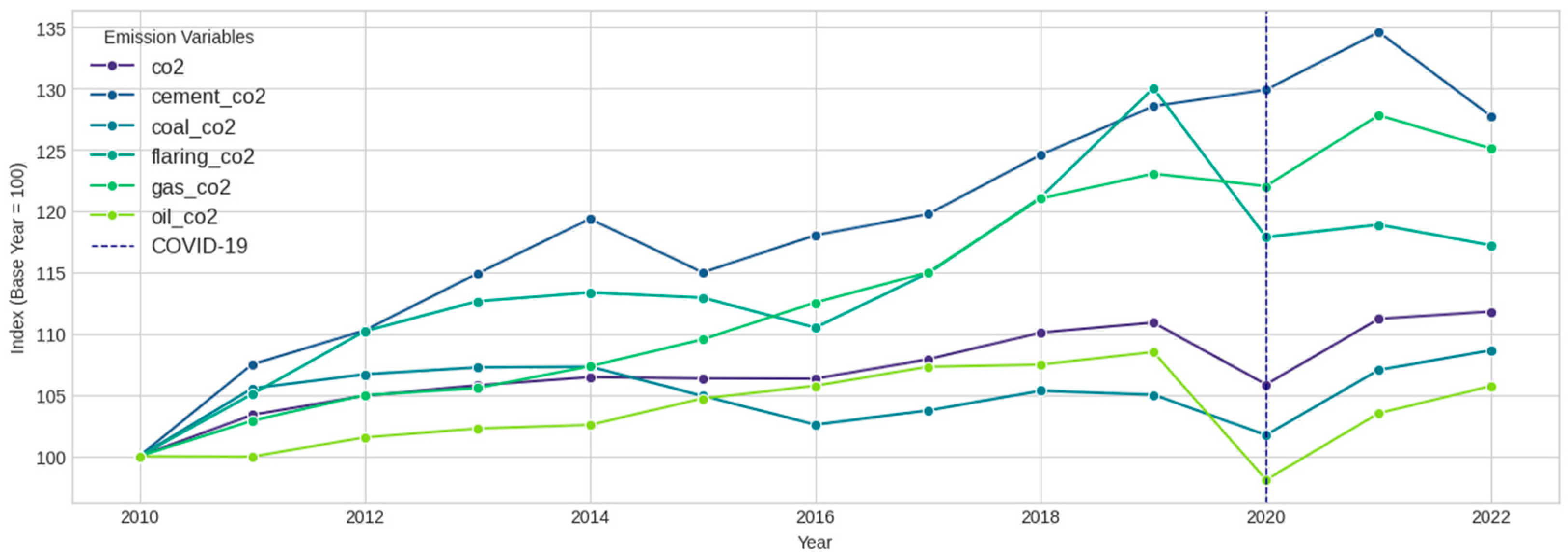
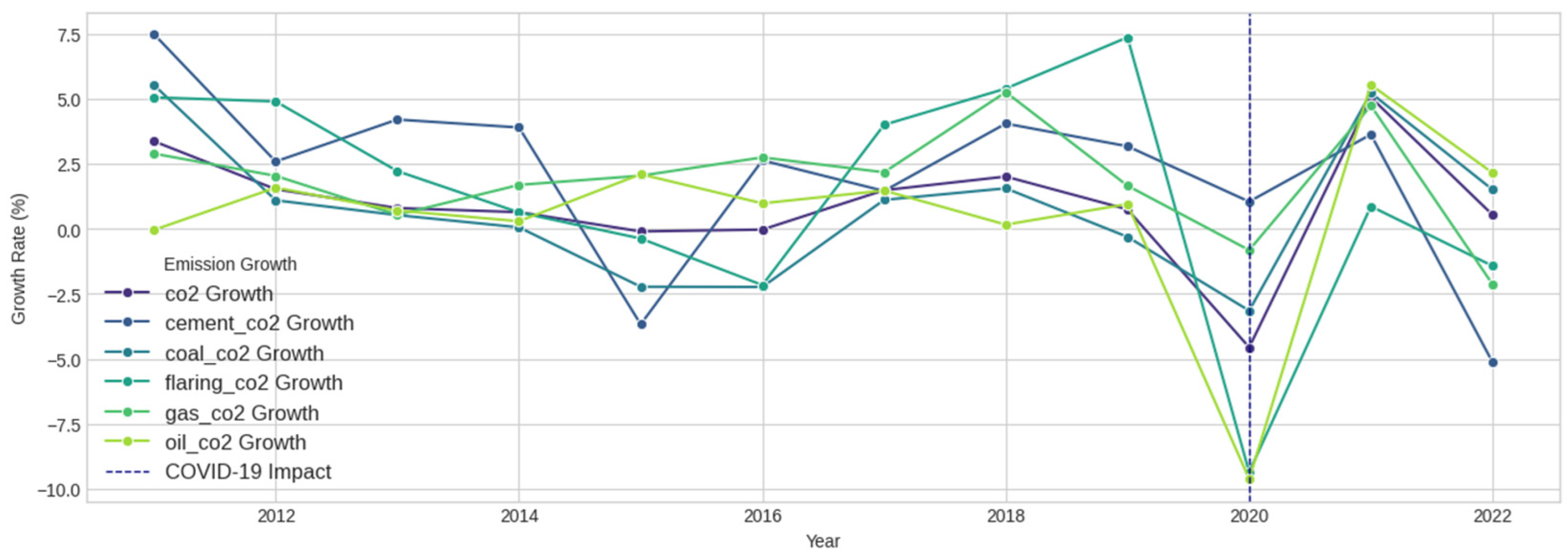
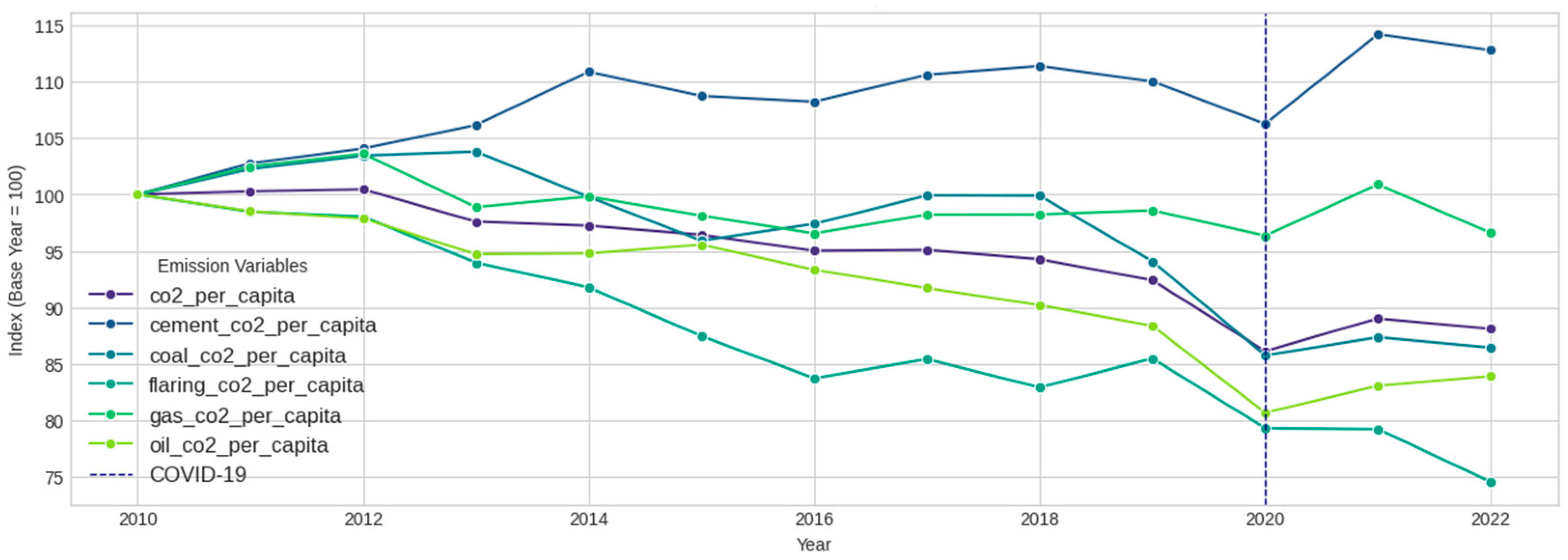
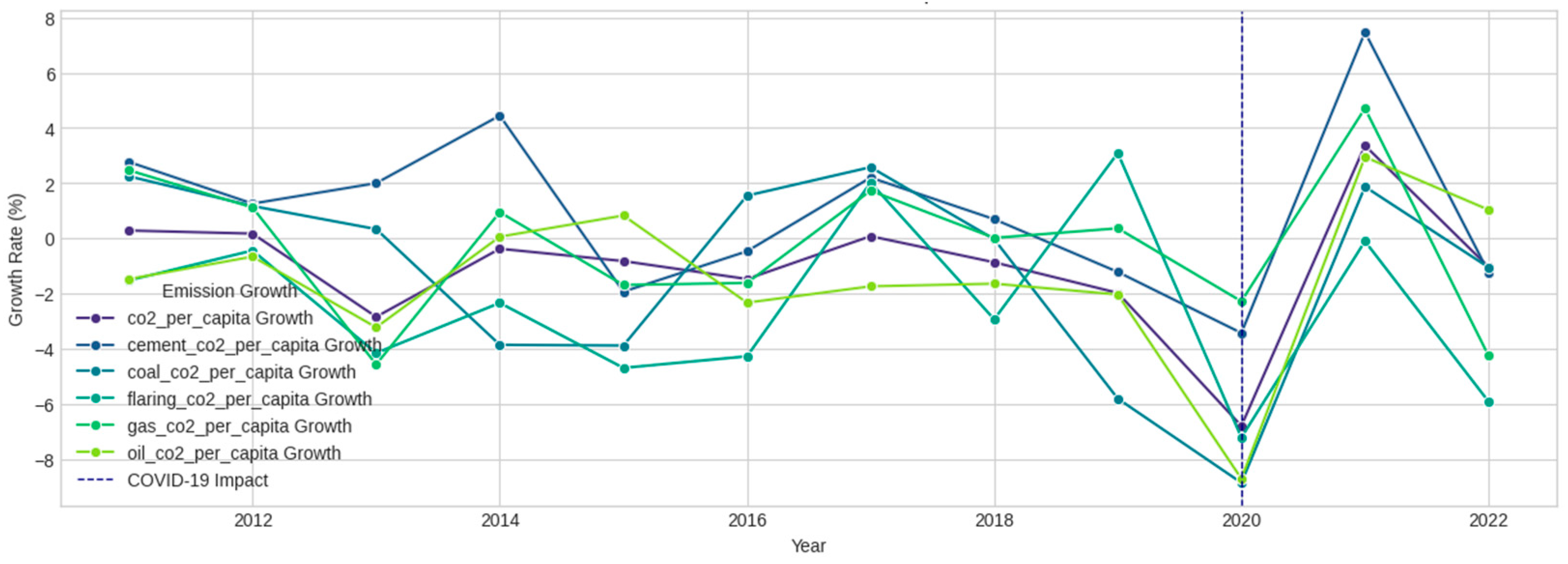
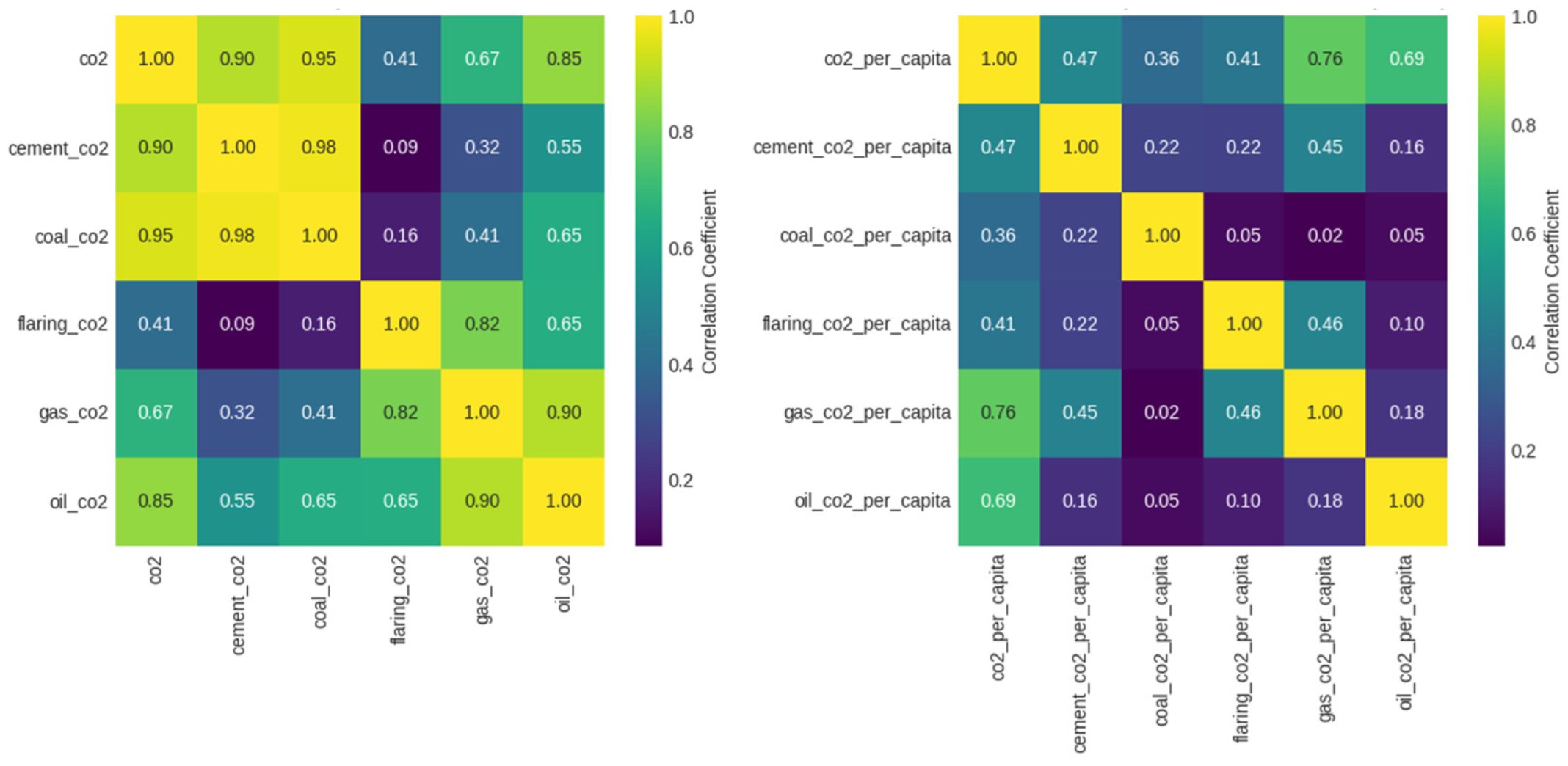



| ID | Variable | OWD Description |
|---|---|---|
| 1 | CO2 | Total annual CO2 emissions, excluding land-use change, measured in million tons. |
| 2 | cement_CO2 | Annual CO2 emissions from cement, measured in million tons. |
| 3 | coal_CO2 | Annual CO2 emissions from coal, measured in million tons. |
| 4 | flaring_CO2 | Annual CO2 emissions from flaring, measured in million tons. |
| 5 | gas_CO2 | Annual CO2 emissions from gas, measured in million tons. |
| 6 | oil_CO2 | Annual CO2 emissions from oil, measured in million tons. |
| 7 | CO2_per_capita | Total annual CO2 emissions per capita, excluding land-use change, measured in tons per person. |
| 8 | cement_CO2_per_capita | Annual CO2 emissions per capita from cement, measured in tons per person. |
| 9 | coal_CO2_per_capita | Annual CO2 emissions per capita from coal, measured in tons per person. |
| 10 | flaring_CO2_per_capita | Annual CO2 emissions per capita from flaring, measured in tons per person. |
| 11 | gas_CO2_per_capita | Annual CO2 emissions per capita from gas, measured in tons per person. |
| 12 | oil_CO2_per_capita | Annual CO2 emissions per capita from oil, measured in tons per person. |
| Calinski–Harabasz Score | Davies–Bouldin Score |
|---|---|
: Total number of points |
| Emissions | Emissions per Capita | ||||
|---|---|---|---|---|---|
| K | Calinski–Harabasz Score | Davies–Bouldin Score | K | Calinski–Harabasz Score | Davies–Bouldin Score |
| 2 | 292.2055 | 0.6177 | 2 | 85.4835 | 1.3363 |
| 3 | 426.8634 | 0.4007 | 3 | 83.1685 | 1.1873 |
| 4 | 539.2618 | 0.4615 | 4 | 78.5524 | 1.0480 |
| 5 | 722.2275 | 0.3873 | 5 | 81.9564 | 1.0041 |
| 6 | 885.5292 | 0.4742 | 6 | 85.6478 | 1.0135 |
| Cluster PCA | CO2 | Cement | Coal | Flaring | Gas | Oil |
|---|---|---|---|---|---|---|
| 1 | 35.7394 | 1.6005 | 10.9583 | 0.4139 | 9.5240 | 13.0532 |
| 2 | 10,173.2746 | 761.5619 | 7424.0688 | 3.9222 | 469.4575 | 1353.8085 |
| 3 | 5297.2622 | 38.2838 | 1402.0755 | 61.3207 | 1507.0304 | 2260.4330 |
| 4 | 535.0613 | 18.2968 | 172.0646 | 10.0039 | 123.5781 | 208.3561 |
| 5 | 1665.7432 | 22.8961 | 401.1005 | 49.4200 | 795.1316 | 380.9303 |
| Cluster t-SNE | CO2 | cement | coal | flaring | gas | oil |
| 1 | 0.2682 | 0.0034 | 0.0006 | 0.0000 | 0.0014 | 0.2628 |
| 2 | 42.2721 | 1.5699 | 8.8626 | 0.5327 | 11.4048 | 19.6092 |
| 3 | 10.6192 | 0.8461 | 3.4490 | 0.0139 | 0.6759 | 5.6263 |
| 4 | 749.3502 | 32.1408 | 331.0221 | 8.6567 | 151.0933 | 219.8762 |
| 5 | 2.3122 | 0.0679 | 0.5565 | 0.0120 | 0.0216 | 1.6541 |
| Cluster PCA | CO2 | Cement | Coal | Flaring | Gas | Oil |
|---|---|---|---|---|---|---|
| 1 | 1.4088 | 0.0475 | 0.1239 | 0.0158 | 0.1705 | 1.0508 |
| 2 | 14.0735 | 0.2184 | 5.5503 | 0.1023 | 1.4771 | 6.6421 |
| 3 | 22.5878 | 0.3836 | 0.2800 | 0.4519 | 14.8261 | 6.6463 |
| 4 | 39.4083 | 0.7862 | 0.0000 | 0.9169 | 33.7095 | 3.9958 |
| 5 | 6.3762 | 0.1661 | 1.2870 | 0.0372 | 1.0818 | 3.7599 |
| 6 | 7.4975 | 0.1525 | 0.4782 | 0.6630 | 3.2760 | 2.9102 |
| Cluster t-SNE | CO2 | cement | coal | flaring | gas | oil |
| 1 | 0.4751 | 0.0095 | 0.0379 | 0.0129 | 0.0244 | 0.3904 |
| 2 | 12.8029 | 0.1922 | 0.4815 | 0.5721 | 7.9014 | 3.6309 |
| 3 | 1.3355 | 0.0873 | 0.2785 | 0.0043 | 0.1556 | 0.8098 |
| 4 | 6.3349 | 0.0012 | 0.0084 | 0.0000 | 0.1815 | 6.1437 |
| 5 | 4.2287 | 0.2231 | 0.5766 | 0.0338 | 1.1025 | 2.2598 |
| 6 | 10.4276 | 0.2389 | 4.4099 | 0.0869 | 2.0267 | 3.5913 |
Disclaimer/Publisher’s Note: The statements, opinions and data contained in all publications are solely those of the individual author(s) and contributor(s) and not of MDPI and/or the editor(s). MDPI and/or the editor(s) disclaim responsibility for any injury to people or property resulting from any ideas, methods, instructions or products referred to in the content. |
© 2024 by the authors. Licensee MDPI, Basel, Switzerland. This article is an open access article distributed under the terms and conditions of the Creative Commons Attribution (CC BY) license (https://creativecommons.org/licenses/by/4.0/).
Share and Cite
Jiménez-Preciado, A.L.; Cruz-Aké, S.; Venegas-Martínez, F. Identification of Patterns in CO2 Emissions among 208 Countries: K-Means Clustering Combined with PCA and Non-Linear t-SNE Visualization. Mathematics 2024, 12, 2591. https://doi.org/10.3390/math12162591
Jiménez-Preciado AL, Cruz-Aké S, Venegas-Martínez F. Identification of Patterns in CO2 Emissions among 208 Countries: K-Means Clustering Combined with PCA and Non-Linear t-SNE Visualization. Mathematics. 2024; 12(16):2591. https://doi.org/10.3390/math12162591
Chicago/Turabian StyleJiménez-Preciado, Ana Lorena, Salvador Cruz-Aké, and Francisco Venegas-Martínez. 2024. "Identification of Patterns in CO2 Emissions among 208 Countries: K-Means Clustering Combined with PCA and Non-Linear t-SNE Visualization" Mathematics 12, no. 16: 2591. https://doi.org/10.3390/math12162591





